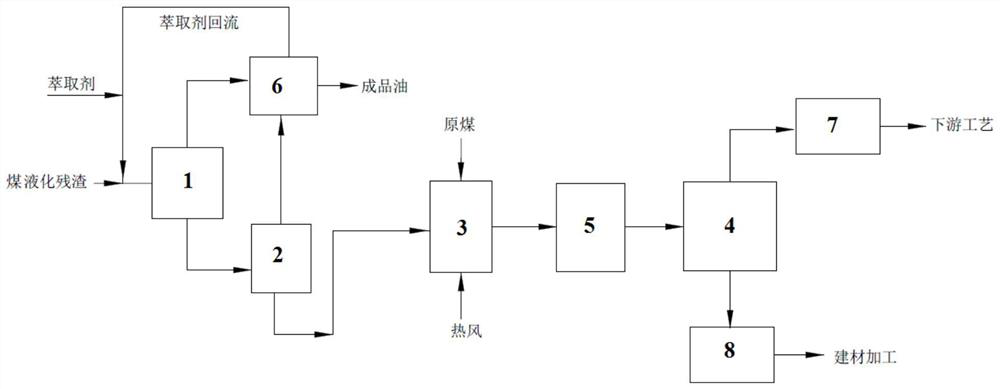System and method for treating direct coal liquefaction residues
A technology for direct liquefaction of coal and residues, which is applied in the preparation of liquid hydrocarbon mixtures, the production of bulk chemicals, and the gasification of granular/powdered fuels. Improve gasification process efficiency and syngas production, high oil recovery, and efficient recovery
- Summary
- Abstract
- Description
- Claims
- Application Information
AI Technical Summary
Problems solved by technology
Method used
Image
Examples
Embodiment 1
[0110] Mix the coal direct liquefaction residue (150kg / h) with n-pentane at a solid-to-liquid mass ratio of 1:4, and conduct supercritical extraction in supercritical extraction unit 1 at 200°C and 4MPa to obtain the extract and solid-liquid mixture.
[0111] The solid-liquid mixture is subjected to solid-liquid separation in the solid-liquid separation unit 2 to obtain raffinate (83.5kg / h) and filtrate, and the extract and filtrate are further processed to obtain refined oil (64.5kg / h).
[0112] Mix the raffinate and raw coal at a mass ratio of 1:12, enter the coal grinding unit 3, and blow hot air during the grinding process. The inlet temperature of the hot air is 180°C, and the outlet temperature of the hot air is 50°C. The required inlet hot air volume for the processing capacity is 3Nm 3 , the pressure difference between the inlet and outlet of the hot air was 1200Pa, and the first powdery mixture was obtained (the total water content was 2.3%, and the volume content of...
Embodiment 2
[0116] Mix the coal direct liquefaction residue (200kg / h) with isopentane at a solid-to-liquid mass ratio of 1:5, and perform supercritical extraction in supercritical extraction unit 1 at 200°C and 5MPa to obtain the extract and solid-liquid mixture.
[0117] The solid-liquid mixture is subjected to solid-liquid separation in the solid-liquid separation unit 2 to obtain raffinate (102.5kg / h) and filtrate, and the extract and filtrate are processed to obtain refined oil (91kg / h).
[0118] The raffinate is mixed with raw coal (according to the mass ratio of 1:7), enters the coal grinding unit 3, and blows hot air during the pulverization process, the inlet temperature of the hot air is 200°C, and the outlet temperature of the hot air is 80°C. The inlet hot air volume required for every 1kg of processing capacity is 2Nm 3 , the pressure difference between the inlet and outlet of the hot air was 1000 Pa, and the first powdery mixture was obtained (the total water content was 2.1...
Embodiment 3
[0122] Mix the coal direct liquefaction residue (250kg / h) with n-hexane at a solid-to-liquid mass ratio of 1:4, and perform supercritical extraction in supercritical extraction unit 1 at 250°C and 4MPa to obtain the extract and solid-liquid mixture .
[0123] The solid-liquid mixture is subjected to solid-liquid separation in the solid-liquid separation unit 2 to obtain a raffinate (131.5kg / h) and a filtrate, and the extract and the filtrate are processed to obtain a refined oil (115kg / h).
[0124] The raffinate and raw coal are mixed at a mass ratio of 1:5, and enter the coal grinding unit 3, and blow hot air during the pulverization process. The inlet temperature of the hot air is 150°C, and the outlet temperature of the hot air is 40°C. The outlet temperature is 50°C, and the inlet hot air volume required for every 1kg of processing capacity is 2Nm 3 , the pressure difference between the inlet and outlet of the hot air was 800 Pa, and the first powdery mixture was obtained...
PUM
| Property | Measurement | Unit |
|---|---|---|
| Particle size | aaaaa | aaaaa |
| Particle size | aaaaa | aaaaa |
| Particle size | aaaaa | aaaaa |
Abstract
Description
Claims
Application Information
 Login to View More
Login to View More - R&D
- Intellectual Property
- Life Sciences
- Materials
- Tech Scout
- Unparalleled Data Quality
- Higher Quality Content
- 60% Fewer Hallucinations
Browse by: Latest US Patents, China's latest patents, Technical Efficacy Thesaurus, Application Domain, Technology Topic, Popular Technical Reports.
© 2025 PatSnap. All rights reserved.Legal|Privacy policy|Modern Slavery Act Transparency Statement|Sitemap|About US| Contact US: help@patsnap.com

